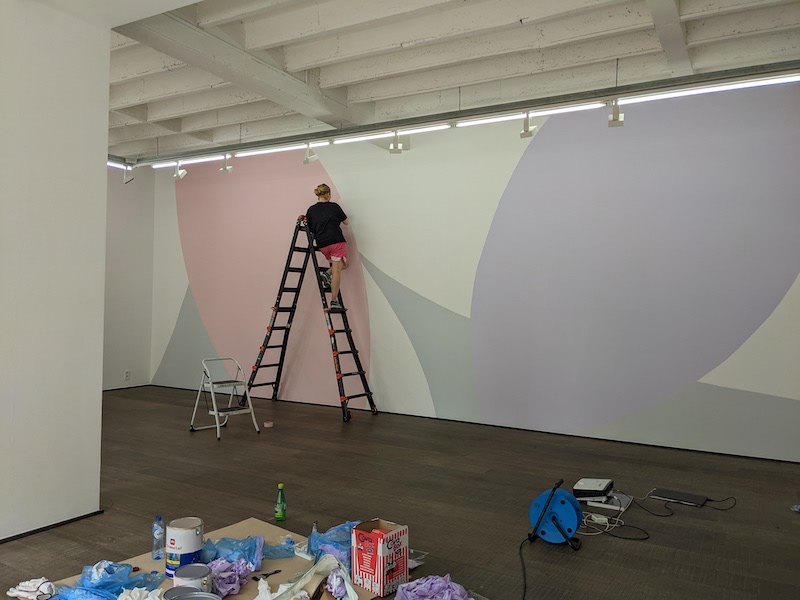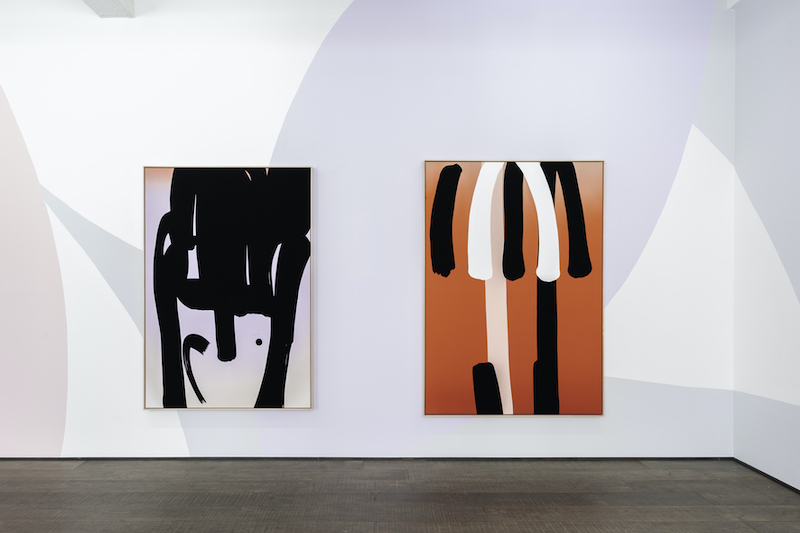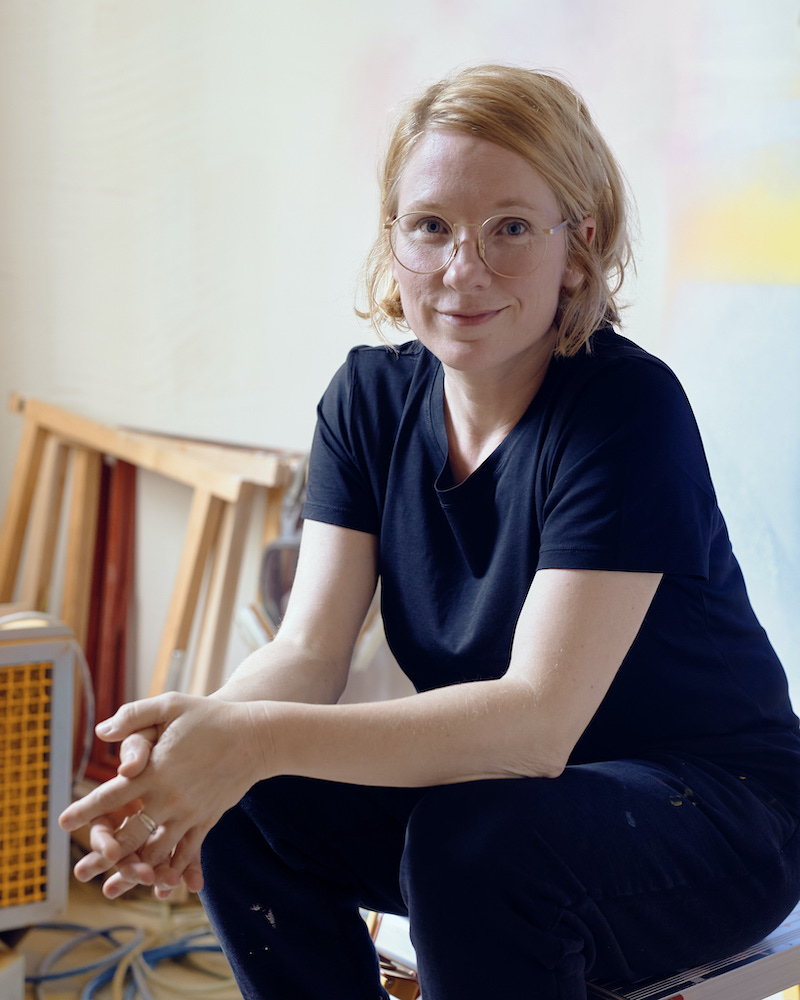 Studio Cornelia Baltes, Photo credit: Cornelia Baltes
Studio Cornelia Baltes, Photo credit: Cornelia Baltes
A bold and strong palette marks the surfaces of Cornelia Baltes’ large paintings: The German artist and London Slade School alumni perfectionated the play between abstract and figurative motifs on intense colour fields. Gradients, spray colours and fine brushstrokes are applied in thin layers. A shape that we may recognise on the canvases could be a peach or a bottom, or perhaps a set of eyes – these forever undefined “characters”, as Baltes refers to her paintings, convey joyfulness and humour. While preparing her solo exhibition “Waggle Dance” at Galerie Rodolphe Janssen in Brussels, we met in her Berlin studio to talk about how she defines titles for her works, about paintings as theatrical objects and about archives of ideas.
Anna-Lena Werner
Cornelia, what will be the title for the show at Rodolphe Janssen in Brussels?
Cornelia Baltes
It will be ‘Waggle Dance’, which is the dance a worker bee does to tell the rest of the hive about the location of, for example, a new source of nectar.
ALW
Typically, your works and exhibitions have short titles. What do these words relate to?
CB
My paintings always feel like ‘characters’ or ‘personalities’ to me. The process of making them relates to a dialog. Installing them in a more site-specific way turns them into characters on a stage. For these reasons, I came up with a system of naming the works. I started with short Scandinavian first names, which morphed over time into abstract last names. It’s basically a flexible framework which acknowledges the individuality of the works: there is often a process of trying to find a title that feels onomatopoeically ‘correct’ – that is, a word that immediately relates to an optical image. It would feel neglectful to me to leave them untitled.
ALW
Why do you never use German titles?
CB
Probably because I received my main art education in London, and I’m so used to all the contextualising and art-thinking happening in English. I like the lightness of the language but also the culture and art of the UK. I once titled one show here in Berlin in German and that felt – in retrospect – a bit rugged.


Studio Cornelia Baltes, Photo credit: Cornelia Baltes
ALW
The paintings’ names feed into this indefinite play between figuration and abstraction, or narration and reduction taking place on most of your works. The titles seem to enhance the insecurity regarding the motif one tries to identify on your paintings…
CB
...I try to keep the names as open as the paintings to avoid being didactic or shutting down potential readings. They are not called “Tomas” or “Dan”, for example.
ALW
What drew you to the title “Waggle Dance”? Have you recently become interested in Apiary?
CB
I did lots of sketches in the Botanical Garden in Berlin prior to the show. The result was that shapes and colours found their way into the work that might refer to ‘flowers’. The bees aren’t in there, but maybe we could think about the audience as the bees?! Another resonance I enjoy is that the waggle dance(s) the worker bees do form very clear, symmetrical patterns. It’s a fascinating, efficient and visual form of communication, which reminds me of the direct way of communicating that the pared down palette and gesture of my paintings uses - skipping the frontal cortex and going in more directly.
ALW
Do some of these botanical sketches appear in the exhibition?
CB
This was very early preparatory work for me. It was mostly about the process of observing and ‘soaking up’ colours, shapes, emotions, environments… Sketching helps me to slow down, and to look and observe more carefully. I sketch more in my studio without referring to this preparation. The important thing was being there in a very receptive state. The way I access this information is through memory rather than returning to the sketches themselves.

Cornelia Baltes, preparing the mural for her exhibition "Waggle Dance" at Rodoplhe Janssen, Brussels
ALW
I remember, once in your previous studio, you showed me a box full of sketches…
CB
…I still do the box! I must sketch A LOT to find a sketch that provides a starting point for a painting. The boxes are part of an ongoing editing process. Some sketches turn into works many years later and many never do, but I’m a big hoarder and can’t throw the sketches away.
ALW
The box I saw was one of many, and it was crowded with sketches that you had been doing over a period of time. When you are preparing for new works or a specific exhibition, do you then flicker through the boxes that you have already, or do you start with a new and specific idea?
CB
Often, I find it easier to see a new painting paired with an older sketch from my archive of ideas. It's a diagonal approach.


Studio Cornelia Baltes, Photo credit: Cornelia Baltes
AWL
How about the colouring of your paintings? How do you determine the colours of the brushstrokes, the spray, the colour-fields or gradients being shown within one exhibition?
CB
The ideas for colours come in different ways. Sometimes it's obvious to me. Sometimes it's a much longer process and I find myself chewing over the colours for a long time. Also, despite being totally convinced about colour choices, sometimes when I step back and look at the finished work, I realise that they were just wrong, and I do the whole painting again. This is annoying, but I’ve learned that I must accept it all as part of the process. When I’m finalising a group of paintings for one concrete show, it also feels as if I’m more observative of my environment. Like the other day, I found some inspiration in an ice cream advertisement. I am aware of the paintings as a group and think carefully about how they interact with each other and the other elements of the installation.
ALW
Some of your paintings reveal one or more gradient colours in the first layer. How come to working with gradients?
CB
I started to work with spray paint in 2014, in search of a way to apply bold fields of colour. Doing so with brushes can be quite tricky and requires several layers, so I started to work with spray cans.
Things developed naturally with the new medium. I tested the water with a borrowed airbrush on a dodgy compressor and things quickly snowballed from there. I find that I’m now at the point where I’m becoming more formally refined in terms of how I'm making use of this particular tool. It’s an important part of the language I’m using, but I’m letting it take more of a supporting role in recent bodies of work
ALW
Where do you do the spraying?
CB
I now have a spray booth with extraction and an airlock in my studio: after years of spending more time on cleaning than working.


Studio Cornelia Baltes, Photo credit: Anna-Lena Werner
ALW
I noticed that very few works of yours are small-scale. Why do you choose for them to be so big?
CB
I somehow have a tendency for big scale paintings. I think it's the body of the viewer and its relation to the gesture. Aside from that it’s the physical connection of the paintings to the space they’re installed in. Small paintings often appear like a window. My paintings are not windows, they are objects in the space…
ALW
…which you often extend with murals and colour fields on the walls.
CB
Yes, I like to ‘surround’ the viewer, I want to embrace them with the work. Currently I am considering placing a carpet in this show, but I’m not sure yet. Some works are still being finalised and I need to resolve the final installation of all the elements simultaneously.
ALW
Do you see your work related to the theatre?
CB
Yes, I often think of a stage – a scenery, with a participatory element. Sometimes it's just the different vantage points and lines of sight when the works are installed in the space. In a more literal sense, I once did a show where paintings on wheels could be rearranged in the space by the audience.



"Waggle Dance", 2022 by Cornelia Baltes, Exhibition views at Rodolphe Janssen, Brussels, Photo credit: HV photography
ALW
Speaking of participatory elements, I wonder whether you enjoy interacting with people when they look at your work, or whether you prefer to be outside of that perception process?
CB
I like to be there and see the reaction of the audience, but ideally without them knowing that I’m the artist. What I really enjoy is doing public art projects. I recently did a mural in a gym in Aarhus in Denmark and a few years ago a piece for The Royal London Hospital in Whitechapel. These works are made for everyone passing through, outside the gallery context and they can be part of someone’s daily life. Soon I’m doing my first public sculpture in London: abstract swans will sit in a water basin in front of the new Elizabeth Line station in Canary Wharf – a powder coated, steel sculpture. Stressed people arrive there, arriving with the tube and heading towards their offices. The sculpture is supposed to be beautiful and awkward at the same time. My point here was to make something funny and joyful.
ALW
I believe your aesthetic language has always been joyful, but it has gradually become more abstract and reduced. Why do you think this happened?
CB
I do notice an ebb and flow and I would say that the works move on a certain spectrum - sometimes more and sometimes a bit less reduced. In terms of a clear shift, my work totally changed about 12 years ago during the Master program in London. At that time, I found a way to make my peace between my painting practice and my graphic design past. I understood my big desire for communicating in a straightforward way through colour, and reduced form - amplification through simplification.

Cornelia Baltes graduated from the Slade School of Fine Art; London in 2011. She has exhibited in solo and group shows at Deichtorhallen Hamburg; Kunstmuseum Bonn; Kunstsammlungen Chemnitz; Museum Wiesbaden; Chapter Arts Center, Cardiff; Mostyn, Llandudno (Wales); Northern Gallery for Contemporary Arts, Sunderland (UK), ICA London, Walker Art Gallery, Liverpool; Royal Academy of Arts, London; Kunsthalle Nuremberg; Museum Folkwang (Essen), Museum Kunst Palast Dusseldorf among many others.
This interview was conducted in July 2022 and also appeared in the catalogue for Cornelia Baltes exhibition "Waggle Dance" at Rodolphe Janssen in Brussels.
Cornelia Baltes
"Waggle Dance"
08.09.-22.10.22
